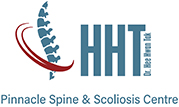Scoliosis Diagnosis
Mild scoliosis may be detected during a routine physical examination. Usually a doctor may suspect scoliosis when a child has one shoulder that seems higher than the other or when clothes don’t seem to “hang right” on a child. In most cases, the doctor will be able to diagnose scoliosis based on a simple, forward-bending test.
The doctor will examine the levels of the shoulders and shoulder blades and the curve of the ribs as the child or adolescent bends slowly forward. A greater dip in one shoulder usually is a sign of scoliosis. Ribs may be curved differently from one side to the other. X-rays aren’t always necessary but may be used to determine the severity of the spine’s curvature.
Once suspected, scoliosis can be confirmed with a diagnostic exam such as an x-ray. The x rays are usually include the whole spine as well as the pelvis and hip joints in the standing position. The curve is then measured in terms of degrees. Generally, a curve is considered significant if it is greater than 25 to 30 degrees. Curves exceeding 45 to 50 degrees are considered more severe.
Sometimes, the spine specialist may order a computed tomography (CT) scan, especially if there are deformed or abnormally shaped bones in the spine. These are usually found in congenital scoliosis where one or more of the spinal bones or vertebrae may be shaped like a triangle (hemivertebra). Magnetic resonance imaging (MRI) of the spine may be ordered if the scoliosis does not fall under the typical scoliosis (teenage scoliosis in a girl, with the scoliotic curve towards the right in the middle back). The reasons for ordering the MRI are to make sure that there are no further issues in the spinal cord and brain complicating the scoliosis.
Treatment Options for Scoliosis
Treating scoliosis depends on your curve, your age, and other factors. If the curve needs to be corrected, a back brace is usually the first option. However, many people have scoliosis so severe it requires surgery. Thanks to advanced technologies in spinal instrumentation as well as nerve monitoring, surgery is much easier than it used to be, and may give you the freedom to resume normal activities.
The treatment of scoliosis depends on the severity of the side-to-side curve in your spine, along with other factors such as your age and physical condition. Non-surgical treatment, such as bracing, is always the first line of treatment in appropriate cases. Many scoliosis curves never progress to the point where surgery is necessary.
Scoliosis Observation
If you or someone you know has scoliosis, observation may be an appropriate treatment option for small spinal curves, curves that are at low risk of worsening, and those with a favorable history once growing has stopped. The spine specialist will be in a good position to advise you on this.
Back Brace
If you have a curve in your spine of 25 to 40 degrees and you are still growing, your doctor may recommend that you wear a back brace. The purpose of wearing this brace is to keep the curve in your spine from getting worse while you grow.
For progressive scoliosis, a customized back brace will be needed to hold the spine straight. The brace is made to extend from the hips to the chest/arm pit, and must be worn for about 16-20 hours a day. The back brace is worn until the skeleton stops growing rapidly, which is usually when adolescents have almost reached full height. The most common type of brace in practice is the Boston brace.
For many young patients, wearing a back brace to school can be very stressful and frustrating. Counselling and support can help children and adolescents adjust and deal with negative feelings and concerns. Without the help of the back brace (and sometimes despite brace use), the scoliosis can get worse and surgery may be required.
An alternative to Boston back brace is the dynamic Spinecor back brace. This brace is more flexible, and may prove to be more acceptable to the patients. However, not all scoliosis cases are suitable for this type of bracing. Idiopathic teenage scoliosis cases are usually suitable for Spinecor bracing. On the other hand, congenital or neuromuscular scoliosis are not suitable candidates for Spinecor back brace.
Physiotherapy
The physiotherapists will work closely with the spine specialists to administer exercise programs and additional therapies to address the back pain and muscular imbalance that can be associated with scoliosis.
Physiotherapy may be an additional tool for patients with scoliosis, but it does not take away the need for constant bracing.
Learn more about the causes for scoliosis and scoliosis surgery options. Our specialist Adjunct A/Professor Hee Hwan Tak is a renowned spine surgeon with much experience treating scoliosis safely and successfully. Contact us for a comprehensive consultation today.
